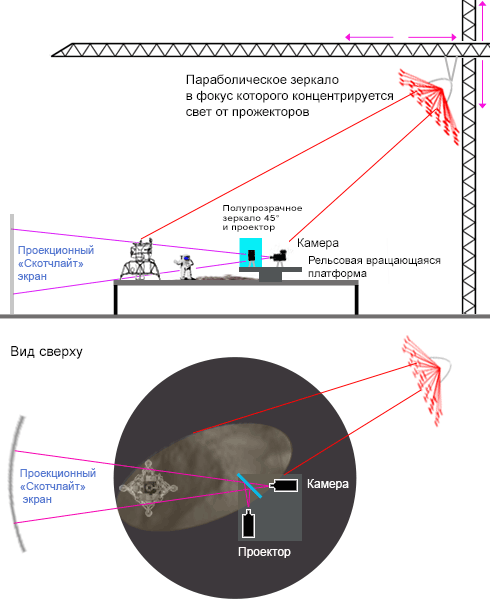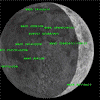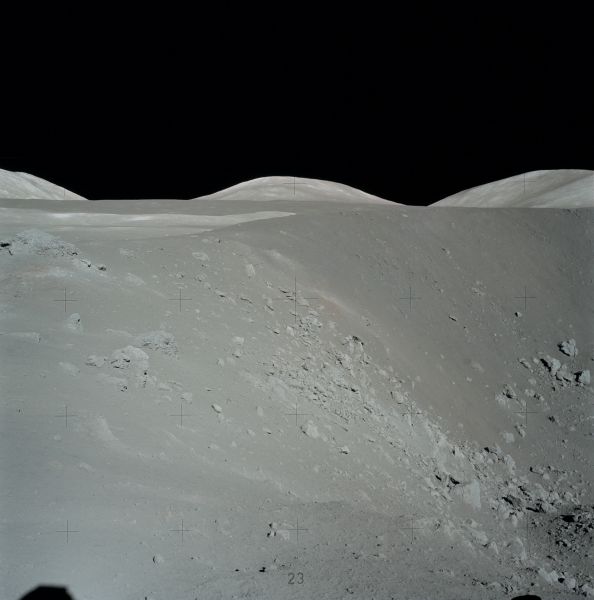-
![[image]](https://www.balancer.ru/cache/sites/ru/ra/radikal/d/d39/1907/d2/128x128-crop/115a4dc0b612.jpg)
Как освещали сцену на съемках лунной аферы
Теги:
aФон>> На фотках она совершенно серая
Passat> Я ли тебе не показывал, что если насыщеность увеличить, грунт явно коричневый?
Passat> Несколько раз показывал, но ты все время глаза закрывал и отворачивался.
Это там где гномон?
Интересно, что сами участники говорят совершенно о другом цвете
Passat> Я ли тебе не показывал, что если насыщеность увеличить, грунт явно коричневый?
Passat> Несколько раз показывал, но ты все время глаза закрывал и отворачивался.
Это там где гномон?
Интересно, что сами участники говорят совершенно о другом цвете
Карр (ЦУП): «На что похожа Луна?»
Ловелл: «Серая, цвета нет, напоминает гипс...»
Андерс: «Или сероватый пляжный песок...»
Т+71:34. В TV-сеансе астронавты показали поверхность Луны. Земляне слушали комментарии.
Борман: «Одно огромное одинокое пространство, безжизненное и угрюмое... Одетая серой пылью пустыня...» Ловелл: «Мили и мили пустынной местности. Ее всеобъемлющая безжизненность вселяет в душу благоговейный страх. Невольно думаешь, как хорошо нам живется на Земле. В беспредельных далях космоса наша планета выглядит прекрасным оазисом».
НОВОСТИ КОСМОНАВТИКИ №2 — 2004


Tarasoff
опытный
roker2019> Оный процесс там не начинался, так что повторюсь, его начало как и завершение вы вольны выдумывать себе самостоятельно, в своей нездоровой головушке. На минеральном форуме, как оказалось, сидят более здоровые люди, чем отдельные здешние обитатели 
Да уж. Более здоровые люди тебе отдельному здешнему обитателю уже 11-ю страницу подряд пытаются донести мысль: грунт реальный, полёты реальные.
Ты ещё десяток друганов туда притащи. Авось, поможет. Ты же измором брать привык. Неа. Не прокатит. И не поможет. Поможет только аминазин тебе в сраку.

Да уж. Более здоровые люди тебе отдельному здешнему обитателю уже 11-ю страницу подряд пытаются донести мысль: грунт реальный, полёты реальные.
Ты ещё десяток друганов туда притащи. Авось, поможет. Ты же измором брать привык. Неа. Не прокатит. И не поможет. Поможет только аминазин тебе в сраку.


Tarasoff
опытный
aФон> Интересно, что сами участники говорят совершенно о другом цвете
Да чо там! Говори сразу: подгоняли цвет Луны под проявленную плёнку аФонь, ты идиот? У тебя видиконы в ультра-эйч-ди снимали. Ковшики карьеры копали. Неужель с цветом партак вышел? Ты поехавший? Последний вопрос был явно лишним.
аФонь, ты идиот? У тебя видиконы в ультра-эйч-ди снимали. Ковшики карьеры копали. Неужель с цветом партак вышел? Ты поехавший? Последний вопрос был явно лишним.
Да чо там! Говори сразу: подгоняли цвет Луны под проявленную плёнку
 аФонь, ты идиот? У тебя видиконы в ультра-эйч-ди снимали. Ковшики карьеры копали. Неужель с цветом партак вышел? Ты поехавший? Последний вопрос был явно лишним.
аФонь, ты идиот? У тебя видиконы в ультра-эйч-ди снимали. Ковшики карьеры копали. Неужель с цветом партак вышел? Ты поехавший? Последний вопрос был явно лишним.


Tarasoff> аФонь, ты идиот? У тебя видиконы в ультра-эйч-ди снимали. Ковшики карьеры копали. Неужель с цветом партак вышел? Ты поехавший? Последний вопрос был явно лишним.
Да, видиконы снимали в UHD, но они были одноканальными, иначе просто не успели бы столько наснимать. То есть снимки с поверхности Луны были черно-белыми, их такими передавал видикон.
Вот что было у США уже в 69-м году
И напомню, как переносится изображение на плёнку, если кто забыл (тут трехканальная схема описана)
Да, видиконы снимали в UHD, но они были одноканальными, иначе просто не успели бы столько наснимать. То есть снимки с поверхности Луны были черно-белыми, их такими передавал видикон.
Вот что было у США уже в 69-м году
The Return Beam Vidicon (RBV) camera system features a recently developed sensor which is capable of producing images with a resolution of 4500 TV lines. Discussed here are the operation of RCA's 2-in RBV and how its primary assets are compatible with the system requirements of programs such as the Earth Resources Observation Satellite. The RBV combines the advantages of the conventional storage vidicon ASOS photoconductor and the orthicon electron multiplier. The sensor operates in a slow-scan mode and utilizes the modulated return beam as a signal path to decrease the signal noise. The primary assets of this device are an improved lowlight sensitivity, with higher signal-to-noise ratios than can be obtained with a conventional vidicon, coupled with extremely high resolution. The 4500-line video signal generated in the 1-in format is converted into a high-quality hard copy print by the Laser Beam Image Reproducer (LBIR). — The high image retention characteristic of the photoconductor makes possible the slow-scan readout of a high-definition (100-ft ground resolution from satellite altitudes), nonsmeared image in limited bandwidth. Thus, a three-camera electronically shuttered system can be used to simultaneously photograph a given section of the Earth's surface in three different spectral bands. Data produced by the sequential readout of the three cameras, when superimposed, can be used to generate a sharp multispectral image. The high-resolution, low image distortion (geometric integrity, shading, etc.), characteristic of the RBV, results from the integration of the vidicon with a carefully controlled electron optic and deflection system. Distributed focus coils are used to obtain minimum spot size and proper beam landing over the full format. The image quality of the RBV/LBIR's high-resolution, low-noise picture is comparable with ground reproduction of present-day film and data transfer techniques used in unmanned surveillance satellites.
(View less)
Published in: Journal of the SMPTE ( Volume: 79 , Issue: 1 , Jan. 1970 )
> A High-Resolution Image Sensor - SMPTE Journals & Magazine
И напомню, как переносится изображение на плёнку, если кто забыл (тут трехканальная схема описана)
The Video-to-Film Color Image Recorder is a recording system which permits precise. The Color Recorder is capable of recording a 9500 x 9000 matrix of picture elements, whereas the maximum resolution of the RBV Camera Sub- system, for example, is approximately 4,500 TV line
A rotating, multifaceted spinner mounted on a translating carriage is utilized to generate the precision raster. After the three modulated beams have been conbined, the composite beam is expanded and focused by a catadioptric lens system (shown in Figure 3) such that it fills two facets of the spinner that folds the converging bundle and scans it across the recording format. In addition to the pictorial information contained in the video signals, the Recorder also has facilities to record an alphanumeric data field of 512 characters (8 rows of 64 characters) composed of any of 42 characters selected by the data processing system. The recording format is comprised of three fields as shown in Figure 4. The 7.5-inch square Picture Format depicted allows the RBV images, to be presented at approximately a 1 : 1,000,000 scale.
> https://www.asprs.org/wp-content/uploads/.../apr/1973_apr_395-400.pdf


Это сообщение редактировалось 26.06.2020 в 19:10
aФон> То есть снимки с поверхности Луны были черно-белыми, их такими передавал видикон.
Откуда же взялись цветные изображения? И ты в курсе вообще, что цветную картинку можно получить при помощи чёрно-белого сенсора или ты слишком тупой даже для этого и нам приходится продумывать детали аферы за тебя?
Откуда же взялись цветные изображения? И ты в курсе вообще, что цветную картинку можно получить при помощи чёрно-белого сенсора или ты слишком тупой даже для этого и нам приходится продумывать детали аферы за тебя?


aФон>> То есть снимки с поверхности Луны были черно-белыми, их такими передавал видикон.
Tangaroa> Откуда же взялись цветные изображения?
Из студии. Снимали на цветную пленку, но проекция лунной поверхности на скотчлайт экран была ЧБ

Не обращайте внимание на параболоид, освещение было устройством, обсуждаемым в этой теме
Tangaroa> И ты в курсе вообще, что цветную картинку можно получить при помощи чёрно-белого сенсора или ты слишком тупой даже для этого и нам приходится продумывать детали аферы за тебя?
Такой вариант увеличил бы время передачи одного кадра втрое, не забывай, что у афермстов было всего пара-тройка месяцев на прием снимков.
Ранее мы уже обсуждали сколько времени требовалось на один кадр такого видикона
Tangaroa> Откуда же взялись цветные изображения?
Из студии. Снимали на цветную пленку, но проекция лунной поверхности на скотчлайт экран была ЧБ

Не обращайте внимание на параболоид, освещение было устройством, обсуждаемым в этой теме
Tangaroa> И ты в курсе вообще, что цветную картинку можно получить при помощи чёрно-белого сенсора или ты слишком тупой даже для этого и нам приходится продумывать детали аферы за тебя?
Такой вариант увеличил бы время передачи одного кадра втрое, не забывай, что у афермстов было всего пара-тройка месяцев на прием снимков.
Ранее мы уже обсуждали сколько времени требовалось на один кадр такого видикона


О, афоня снова взялся аферу снимать. С неподвижной вращающейся платформы, освещенной неизвестным прибором, который он так и не смог начертить. 



aФон>>> То есть снимки с поверхности Луны были черно-белыми, их такими передавал видикон.
Tangaroa>> Откуда же взялись цветные изображения?
aФон> Из студии.
и цветные фото грунта тоже?
aФон> Снимали на цветную пленку,
да, именон так - астронавты снимали на цветную плёнку.
aФон> но проекция лунной поверхности на скотчлайт экран была ЧБ
нет, никакой проеции "на скотчлайт" не было, его попросту не взяли на Луну.
aФон> Не обращайте внимание на параболоид,
А я и не обращаю - это же, очевидно, творчество душевнобольного.
Tangaroa>> И ты в курсе вообще, что цветную картинку можно получить при помощи чёрно-белого сенсора или ты слишком тупой даже для этого и нам приходится продумывать детали аферы за тебя?
aФон> Такой вариант увеличил бы время передачи одного кадра втрое,
так проклятые аферисты же обладают ничем не ограниченными возможностями. К тому же, передавать можно сразу по трём каналам. Да хоть по десяти.
aФон> не забывай, что у афермстов было всего пара-тройка месяцев на прием снимков.
не забывай, что ты до сих пор не привёл никаких доказательств аферы
aФон> Ранее мы уже обсуждали сколько времени требовалось на один кадр такого видикона
ранее мы уже обсуждали, что ты идиот.
Tangaroa>> Откуда же взялись цветные изображения?
aФон> Из студии.
и цветные фото грунта тоже?
aФон> Снимали на цветную пленку,
да, именон так - астронавты снимали на цветную плёнку.
aФон> но проекция лунной поверхности на скотчлайт экран была ЧБ
нет, никакой проеции "на скотчлайт" не было, его попросту не взяли на Луну.
aФон> Не обращайте внимание на параболоид,
А я и не обращаю - это же, очевидно, творчество душевнобольного.
Tangaroa>> И ты в курсе вообще, что цветную картинку можно получить при помощи чёрно-белого сенсора или ты слишком тупой даже для этого и нам приходится продумывать детали аферы за тебя?
aФон> Такой вариант увеличил бы время передачи одного кадра втрое,
так проклятые аферисты же обладают ничем не ограниченными возможностями. К тому же, передавать можно сразу по трём каналам. Да хоть по десяти.
aФон> не забывай, что у афермстов было всего пара-тройка месяцев на прием снимков.
не забывай, что ты до сих пор не привёл никаких доказательств аферы
aФон> Ранее мы уже обсуждали сколько времени требовалось на один кадр такого видикона
ранее мы уже обсуждали, что ты идиот.


Tangaroa> и цветные фото грунта тоже?
Но грунт же черно-белый на фото.
Не исключено, что в рамках А-16 опустили на Луну Луноход с трехканальным видиконом, потому что на снимках А-17 есть подобие цвета у грунта
Но грунт же черно-белый на фото.
Не исключено, что в рамках А-16 опустили на Луну Луноход с трехканальным видиконом, потому что на снимках А-17 есть подобие цвета у грунта


Tangaroa>> и цветные фото грунта тоже?
aФон> Но грунт же черно-белый на фото.
Так он же цветной на фото. Причём на всех фотографиях, котоыре сделаны на цвентную плёнку (на ч/б он, само собой, ровно серый).
aФон> Не исключено, что в рамках А-16 опустили на Луну Луноход
мало того, луноход спустили ещё в рамках А-15, астронавты использовали его для перемещений на большие расстояния
aФон> с трехканальным видиконом,
Да, именно так всё и было, астронавты использовали "трёхканальные видиконы" (на самом деле, одноканальные, но с вращающимся светофильтром) в камерах на роверах, чтобы снимать всё, чем они занимались во время работы на поверхности. Наконец-то ты узнал, что у американцев были цветные телекамеры.
aФон> Но грунт же черно-белый на фото.
Так он же цветной на фото. Причём на всех фотографиях, котоыре сделаны на цвентную плёнку (на ч/б он, само собой, ровно серый).
aФон> Не исключено, что в рамках А-16 опустили на Луну Луноход
мало того, луноход спустили ещё в рамках А-15, астронавты использовали его для перемещений на большие расстояния
aФон> с трехканальным видиконом,
Да, именно так всё и было, астронавты использовали "трёхканальные видиконы" (на самом деле, одноканальные, но с вращающимся светофильтром) в камерах на роверах, чтобы снимать всё, чем они занимались во время работы на поверхности. Наконец-то ты узнал, что у американцев были цветные телекамеры.


Tangaroa>>> и цветные фото грунта тоже?
aФон>> Но грунт же черно-белый на фото.
Tangaroa> Так он же цветной на фото. Причём на всех фотографиях, котоыре сделаны на цвентную плёнку (на ч/б он, само собой, ровно серый).
Верно, серый грунт на цветном фото, потому что слайды были ЧБ.
Но чтобы лохи думали, что грунт у них цветной, им бросили кость, когда на сцене насыпан цветной песок (без заднего фона) и показан гномон.
Дескать, лошары, смотрите, грун-то у нас цветной, вот лошары, вроде тебя, и говорят о цветном грунте.
Но разуй глаза, грунт у них серый на всех кадрах
aФон>> Но грунт же черно-белый на фото.
Tangaroa> Так он же цветной на фото. Причём на всех фотографиях, котоыре сделаны на цвентную плёнку (на ч/б он, само собой, ровно серый).
Верно, серый грунт на цветном фото, потому что слайды были ЧБ.
Но чтобы лохи думали, что грунт у них цветной, им бросили кость, когда на сцене насыпан цветной песок (без заднего фона) и показан гномон.
Дескать, лошары, смотрите, грун-то у нас цветной, вот лошары, вроде тебя, и говорят о цветном грунте.
Но разуй глаза, грунт у них серый на всех кадрах


Tangaroa>>>> и цветные фото грунта тоже?
aФон> aФон>> Но грунт же черно-белый на фото.
Tangaroa>> Так он же цветной на фото. Причём на всех фотографиях, котоыре сделаны на цвентную плёнку (на ч/б он, само собой, ровно серый).
aФон> Верно, серый грунт на цветном фото, потому что слайды были ЧБ.
Верно, грунт серый, потому что он и так преимущественно серый, а слайбы были цветные.
aФон> Но разуй глаза, грунт у них серый на всех кадрах
На всех чёрно-белых, да. На цветных - нет, не серый.
aФон> aФон>> Но грунт же черно-белый на фото.
Tangaroa>> Так он же цветной на фото. Причём на всех фотографиях, котоыре сделаны на цвентную плёнку (на ч/б он, само собой, ровно серый).
aФон> Верно, серый грунт на цветном фото, потому что слайды были ЧБ.
Верно, грунт серый, потому что он и так преимущественно серый, а слайбы были цветные.
aФон> Но разуй глаза, грунт у них серый на всех кадрах
На всех чёрно-белых, да. На цветных - нет, не серый.


aФон>> Верно, серый грунт на цветном фото, потому что слайды были ЧБ.
Tangaroa> Верно, грунт серый, потому что он и так преимущественно серый, а слайбы были цветные.
Какой же серый, если доставленные образцы грунта - коричневые?
Там что освещение другое?
> О цвете Луны: a_kudryavets — ЖЖ
Tangaroa> Верно, грунт серый, потому что он и так преимущественно серый, а слайбы были цветные.
Какой же серый, если доставленные образцы грунта - коричневые?
Там что освещение другое?
> О цвете Луны: a_kudryavets — ЖЖ


aФон>> Какой же серый, если доставленные образцы грунта - коричневые?
Xan> Аж даже линейка от грунта покоричневела!!!
Линейка ниже, чем пробирка с грунтом, поэтому и окращивается отраженным светом
Xan> Аж даже линейка от грунта покоричневела!!!

Линейка ниже, чем пробирка с грунтом, поэтому и окращивается отраженным светом


aФон>>> Верно, серый грунт на цветном фото, потому что слайды были ЧБ.
Tangaroa>> Верно, грунт серый, потому что он и так преимущественно серый, а слайбы были цветные.
aФон> Какой же серый, если доставленные образцы грунта - коричневые?
так они ж серые. Ты что, не видишь? Серые, натурально! Да и вообще, российские учёные доказали, что на Луне цвета нет совсем.
Кстати, Сёрвейеры тоже передавали цветные изображения, сли их хорошо об этом попросить. Я не шучу.
Tangaroa>> Верно, грунт серый, потому что он и так преимущественно серый, а слайбы были цветные.
aФон> Какой же серый, если доставленные образцы грунта - коричневые?
так они ж серые. Ты что, не видишь? Серые, натурально! Да и вообще, российские учёные доказали, что на Луне цвета нет совсем.
Кстати, Сёрвейеры тоже передавали цветные изображения, сли их хорошо об этом попросить. Я не шучу.


aФон>>> Какой же серый, если доставленные образцы грунта - коричневые?
Xan>> Аж даже линейка от грунта покоричневела!!!
aФон> Линейка ниже, чем пробирка с грунтом,
точно - грунт ниже линейки, но она ниже грунта! Всё сходится!
Xan>> Аж даже линейка от грунта покоричневела!!!

aФон> Линейка ниже, чем пробирка с грунтом,
точно - грунт ниже линейки, но она ниже грунта! Всё сходится!


Tangaroa> Кстати, Сёрвейеры тоже передавали цветные изображения, сли их хорошо об этом попросить. Я не шучу.
Передавали, но не в UHD качестве.
Видикон, который был на Луноходах миссий Аполлон был одноканальным из-за относительно большого времени передачи данных , требуемого на одно фото в таком высоком разрешении.
В миссии А-17 (Луноход, доставленный в А-16) можно видеть отдельные фотографии в цвете, то есть в этой миссии поставили на видикон фильтры и иногда принимали фото по треем цветовым каналам
Передавали, но не в UHD качестве.
Видикон, который был на Луноходах миссий Аполлон был одноканальным из-за относительно большого времени передачи данных , требуемого на одно фото в таком высоком разрешении.
В миссии А-17 (Луноход, доставленный в А-16) можно видеть отдельные фотографии в цвете, то есть в этой миссии поставили на видикон фильтры и иногда принимали фото по треем цветовым каналам


Tangaroa>> Кстати, Сёрвейеры тоже передавали цветные изображения, сли их хорошо об этом попросить. Я не шучу.
aФон> Передавали, но не в UHD качестве.
aФон> Видикон, который был на Луноходах миссий Аполлон был одноканальным
Да, именно так, поэтому для передачи цветного изображения использовался вращающийся диск со RGB-светофильтрами. Из-за этого в кадре предметы иногда как бы троятся, получаются с тройным контуром разных цветов.
aФон> из-за относительно большого времени передачи данных , требуемого на одно фото в таком высоком разрешении.
Нет, видиконы использовались для передачи телеизображения. Фотографии в миссиях "Аполлонов" получены методом, традиционным для того времени - на плёнку.
aФон> В миссии А-17 (Луноход, доставленный в А-16) можно видеть отдельные фотографии в цвете,
на всех кассетах с цветной плёнкой все фотографии в цвете. На чёрно-белых кассетах - нет.
aФон> то есть в этой миссии поставили на видикон фильтры и иногда принимали фото по треем цветовым каналам
То есть, ты снова забыл принять таблетки.
aФон> Передавали, но не в UHD качестве.
aФон> Видикон, который был на Луноходах миссий Аполлон был одноканальным
Да, именно так, поэтому для передачи цветного изображения использовался вращающийся диск со RGB-светофильтрами. Из-за этого в кадре предметы иногда как бы троятся, получаются с тройным контуром разных цветов.
aФон> из-за относительно большого времени передачи данных , требуемого на одно фото в таком высоком разрешении.
Нет, видиконы использовались для передачи телеизображения. Фотографии в миссиях "Аполлонов" получены методом, традиционным для того времени - на плёнку.
aФон> В миссии А-17 (Луноход, доставленный в А-16) можно видеть отдельные фотографии в цвете,
на всех кассетах с цветной плёнкой все фотографии в цвете. На чёрно-белых кассетах - нет.
aФон> то есть в этой миссии поставили на видикон фильтры и иногда принимали фото по треем цветовым каналам
То есть, ты снова забыл принять таблетки.


Tangaroa> Да, именно так, поэтому для передачи цветного изображения использовался вращающийся диск со RGB-светофильтрами. Из-за этого в кадре предметы иногда как бы троятся, получаются с тройным контуром разных цветов.
Ныне, наряду с утрированным печатным растром и браком разных печатных технологий, смещение цветовых каналов доведено до выразительного эффекта под названием "глитч"
Ныне, наряду с утрированным печатным растром и браком разных печатных технологий, смещение цветовых каналов доведено до выразительного эффекта под названием "глитч"


Tangaroa>> На всех чёрно-белых, да. На цветных - нет, не серый.
roker2019> Это не серый???
roker2019> https://farm1.staticflickr.com/764/21028582504_3d3475165c_c.jpg
Пирожочек, а это что вообще такое? Что это за картинка у тебя? Каково ее происхождение?
roker2019> Это не серый???
roker2019> https://farm1.staticflickr.com/764/21028582504_3d3475165c_c.jpg
Пирожочек, а это что вообще такое? Что это за картинка у тебя? Каково ее происхождение?



Tangaroa>>> На всех чёрно-белых, да. На цветных - нет, не серый.
roker2019>> Это не серый???
roker2019>> https://farm1.staticflickr.com/764/21028582504_3d3475165c_c.jpg
Taler> Пирожочек, а это что вообще такое? Что это за картинка у тебя? Каково ее происхождение?
Это ёпта кадр AS16-113-18339, Apollo 16 Magazine 113/A (Color) Orbit & Post-Landing; NASA photographs; unprocessed 1800 dpi Hasselblad film scans by Johnson Space Center, circa 2005
roker2019>> Это не серый???
roker2019>> https://farm1.staticflickr.com/764/21028582504_3d3475165c_c.jpg
Taler> Пирожочек, а это что вообще такое? Что это за картинка у тебя? Каково ее происхождение?

Это ёпта кадр AS16-113-18339, Apollo 16 Magazine 113/A (Color) Orbit & Post-Landing; NASA photographs; unprocessed 1800 dpi Hasselblad film scans by Johnson Space Center, circa 2005


Tangaroa>> На всех чёрно-белых, да. На цветных - нет, не серый.
roker2019> Это не серый???
roker2019> https://farm1.staticflickr.com/764/21028582504_3d3475165c_c.jpg
Я не знаю, откуда ты достал это изображение и как ты его отфотошопил. Давай необработанное.
roker2019> Это не серый???
roker2019> https://farm1.staticflickr.com/764/21028582504_3d3475165c_c.jpg
Я не знаю, откуда ты достал это изображение и как ты его отфотошопил. Давай необработанное.


Tangaroa>> На всех чёрно-белых, да. На цветных - нет, не серый.
roker2019> Это не серый???
и, кстати, да - не серый. Серый это когда три цветовых компоненты совпадают (R=G=B). А если не совпадают, тогда уже не серый.
roker2019> Это не серый???
и, кстати, да - не серый. Серый это когда три цветовых компоненты совпадают (R=G=B). А если не совпадают, тогда уже не серый.


Copyright © Balancer 1997..2021
Создано 20.07.2019
Связь с владельцами и администрацией сайта: anonisimov@gmail.com, rwasp1957@yandex.ru и admin@balancer.ru.
Создано 20.07.2019
Связь с владельцами и администрацией сайта: anonisimov@gmail.com, rwasp1957@yandex.ru и admin@balancer.ru.
 aФон
aФон

 инфо
инфо инструменты
инструменты aФон
aФон


 aФон
aФон
 aФон
aФон

 aФон
aФон


 Xan
Xan






 roker2019
roker2019

